 |
 |
 |
| |
New HIV Drugs, Final Oral Slide Session at ICAAC 2007
|
| |
| |
ICAAC sept 17-20, 2007 Chicago
Reported by Jules Levin
The main HIV oral slide session ended earlier today and there several interesting presentations, updates on new HIV drugs. This was CCR5 day. Two presentations on Maraviroc presented positive findings regarding safety and efficacy with longer-term followup. One Maraviroc study reports on tropism in MOTIVATE. PRO 140 showed promising results regarding efficacy and safety and an improved administration will be used in the next study. In the poster session the new CCR5 from Incyte received attention with 4 posters showing with early data that the drug appears to be able to be used with and without ritonavir boosting, it has a long half-life, good efficacy results were reported in Sydney. Also discussed below were presentations from the ARTEMIS Study comparing Darunavir once daily to Kaletra, pooled data from DUET 1 & 2. 48 weeks raltegravir data from phase II in treatment-experienced. And an updated analysis on the Gilead integrase elvitegravir, from the data reported at CROI.
Raltegravir (Merck integrase) phase II 48-weeks study results in treatment experienced were presented. These are the longest data we have seen in treatment-experienced; PSS of 0 to PI was over 90%; PSS of 0 to all ARTs was 50% or more. The mean baseline CD4 count was 240. The authors summarized 64-71% of patients had <400 copies/ml and 46-64% had <50 c/ml at week 48; it's important to remember 3 doses of raltegravir were used in the phase II study and darunavir and tipranavir were not used in the study. Viral load reduction was on average about - 2.2 log by week 4, -1.9 log at week 24, and a little less at week 48.CD4 increased about 100 by week 48. 20% or more used Fuzeon first-time.
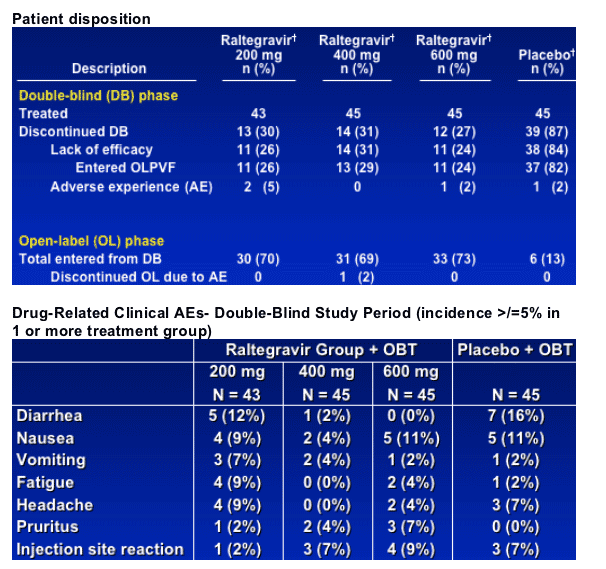
Andy Zolopa reported an updated analysis of elvitegravir (EVG), the Gilead integrase drug. Patients received EVG boosted with RTV once daily plusOBT +/- Fuzeon or CPI/r (boosted PI) plus OBT. This also was a drug-experienced population with 32-35% having GSS=0, 11 PI resistance matations, and 12% in CPI group & 19% in EVG group using Fuzeon for first time. HIV-RNA <50 c/ml at week 16 for patients with first use of T20: 25% for CPI group, 74% for EVG 125mg group. For patients with first use of T20 with or without active NRTIs viral load reduction was - 2.9 log for EVG 125 mg group (n=19); for patients with no active OBT viral load reduction was -0.7 log, and for patients with >1 active NRTI without first use Fuzeon VL reduction wad -1.7 log, all at week 24. The CPI group had a -1.8 VL reduction at week 24. Week 16 VL <50 c/ml for patients receiving EVG/r 125 mg:15% with no active OBT, 30% with 1 active NRTI without first use Fuzeon, 44% with 2 or more active NRTIs without first use Fuzeon, and 74% for patients with first use Fuzeon and with or without active NRTIs.
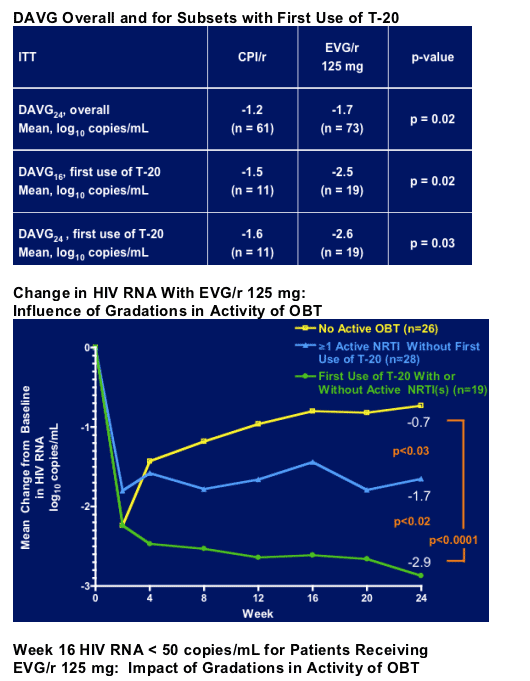
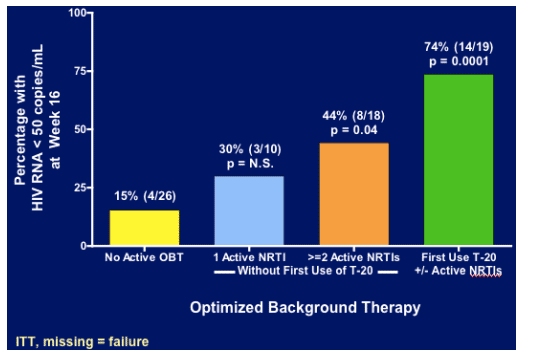
Pfizer presented "Changes in HIV-1 Co-Receptor Tropism for Patients Participating in Maraviroc MOTIVATE 1 & 2 Clinical Trials".
Patients With a Change in Tropism Result from R5 at Screening to D/M at Baseline had a Lower Median CD4+ Count
--Of the 1042 patients with R5 virus at screening, approximately 8% had a change in tropism result between screening and baseline to non-R5 virus, prior to a change in ARV regimen or administration of study drug
--This subgroup had a lower median CD4+ count and higher mean HIV-1 RNA at screening
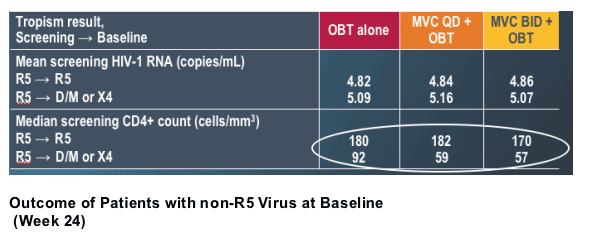
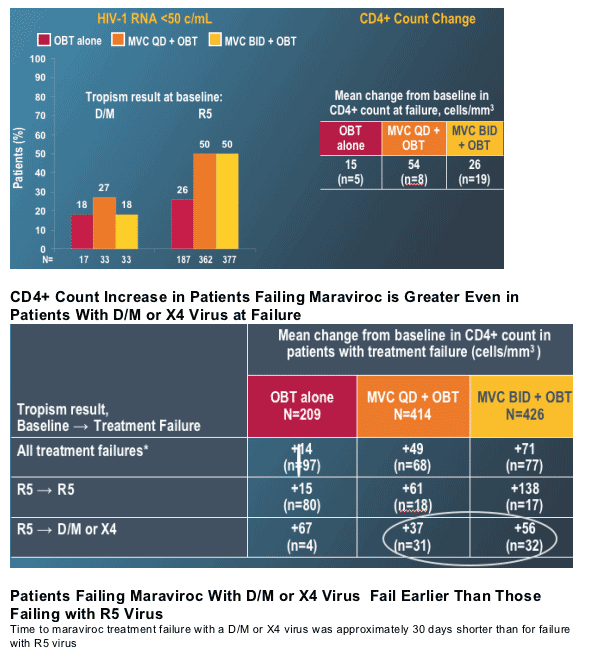
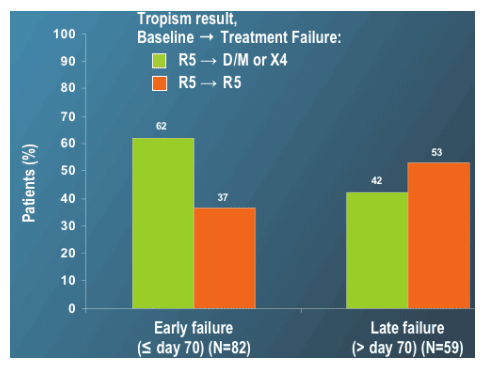
They summarized:
--the number of patients experiening CDC category C events in the study was low: 14 (6.7%) OBT alone, 26 (6.3%) MVC QD and 18 (4.2%) MVC BID.
--There was no evidence of an increased rate of Category C events in patients receiving MVC+OBT vs those receiving OBT alone despite the extended treatment duration on MVC.
--Only 5 patients with R5 virus at baseline who experienced a Category Cevent had D/M or X4 virus at the time of the event (3 on MVC QD, 1 on MVC BID, and 1 on OBT alone).
--All 5 patients had a baseline CD4 count <20 and thereforeat high risk of developing a Category C event.
--Category C events were thereforenot associated with treatment emergent CXCR4-using virus.
Regarding switches from R5 to X4:
--Maraviroc selectively inhibits R5 virus.
--If MVC is administered as part of a suboptimal regimen, pre-existing low (undetected) levels of D/M or X4 will emerge as the dominant population.
--Since the D/M or X4 is pre-existing, time to failure is shorter than R5 virus (where MC resistance must be selected do novo): similar to the rapid outgrowth of pre-existing (archived) drug-resistant virus when failed ARV therapy is reinitiated after treatment interruption.
--After withdrawal of MVC, selective pressure on R5 virus is removed, allowing R5 virus to re-emerge as the dominant population. Reversion to R5 takes about 16 weeks consistent with loss of 3TC or Fuzeonresistance after withdrawalof those ARVs.
Conclusions:
--Tropism changes are associated with MVC treatment failure
--Patients failing MVC therapy had higher mean CD4 count increases even in the context of emergence of D/M or X4 virus.
--Time to failure was shorter for patients failing with D/M or X4 virus vs R5
--Patients who failed MVC therapy with D/M or X4 reverted to an R5 tropism after cessation of MVC therapy.
--There was no association between Category C events & treatment emergent D/M or X4 virus.
--These data are consistent with the selective and reversible suppression of R5 virus during MVC therapy, resulting in detection of D/M or X4 virus at time of failure in two-thirds of failing patients.
Jeff Jacobson reported on the activity & PK of PRO 140, a CCR5 monoclonal antibody, in HIV+ individuals. Drug was administered by a one-time infusion but will be switched to subcutaneous injection for next study, and they will explore a higher dose since dose in this study was safe. 40 patients were randomized to placebo or 1 of 3 drug doses. There were no drug-related serious AEs, no dose-limiting toxicity, no obvious pattern of toxicity, and no difference rrelative to placebo in change in co-receptor tropism; post-treatment D/M trpoism occurred to 1/30 patients on PRO140 & 1/9 on placebo. Mean viral load reduction - 1.70 log at day 10 using highest dose (5mg/kg); VL slowly went back to baseline over 2-3 weeks. No drug resistance was yet found.
Tibotec reported results for pooled data from DUET 1 & 2. The data was similar as when presented separately in the Lancet as DUET 1 and DUET 2. 59% at wek 24 had <50 c/ml with TMC125+OBT vs 41% with placebo+OBT. K103N does not appear to afect TMC125 response. Side effect profile looks good. 17% on TMC125 got rash vs 9% in placebo. Nervous system disorders, psych dosorders, and hepatic AEs were experienced at same rates in placebo They said rash was usually mild to moderate, 1.3% with grade 3 and no grade 4, no rash with mucosal involvement, and only 2.2% led to permanent discontinuation; no increased risk in patients with a history of NNRTI rash. Short median duration of rash 11 days; most frequent in 2nd week of therapy, median onset day 12.
Baseline characteristics
and background ARVs
Baseline CD4 counts were 100 in both groups. Prior ARV use: 65% used 10-15 ARVs; 62% had 4 or more primary PI mutations; 46% previously used Fuzeon; 27% de novo Fuzeon use; 16% had no active background drugs; 37% had 1 active background drug.

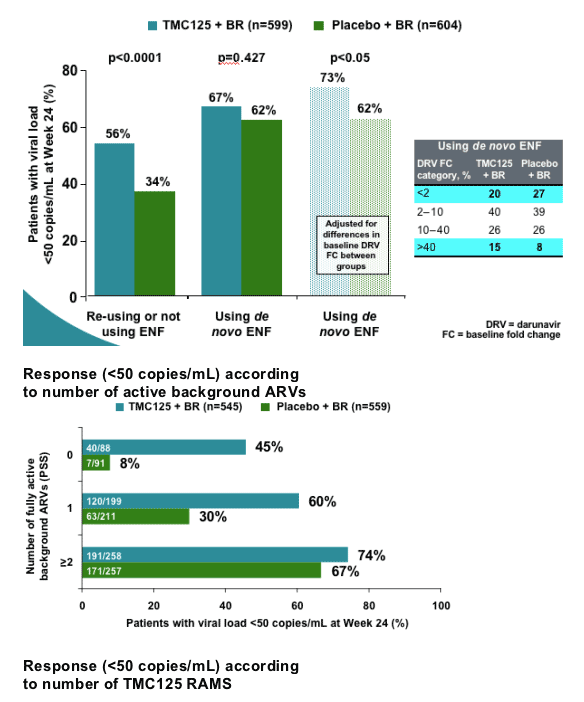
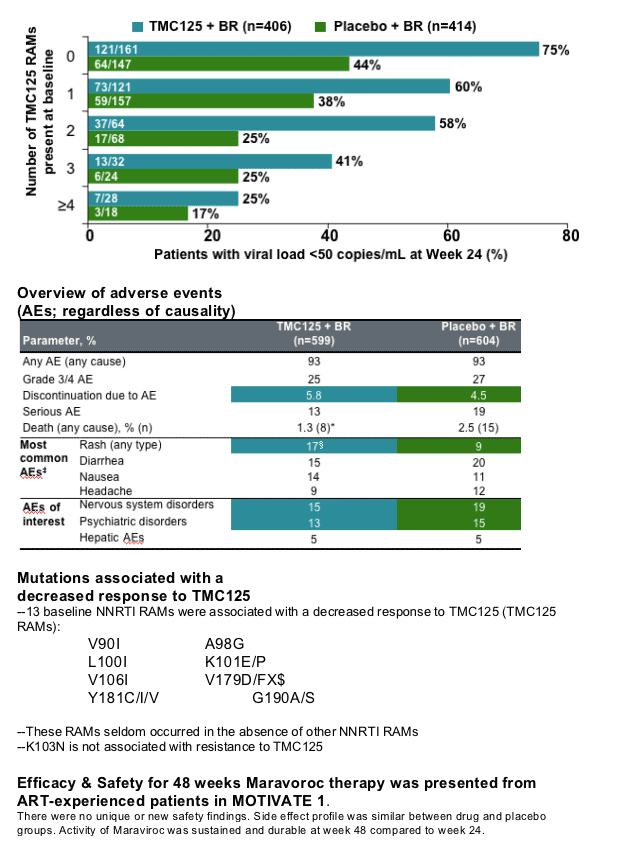
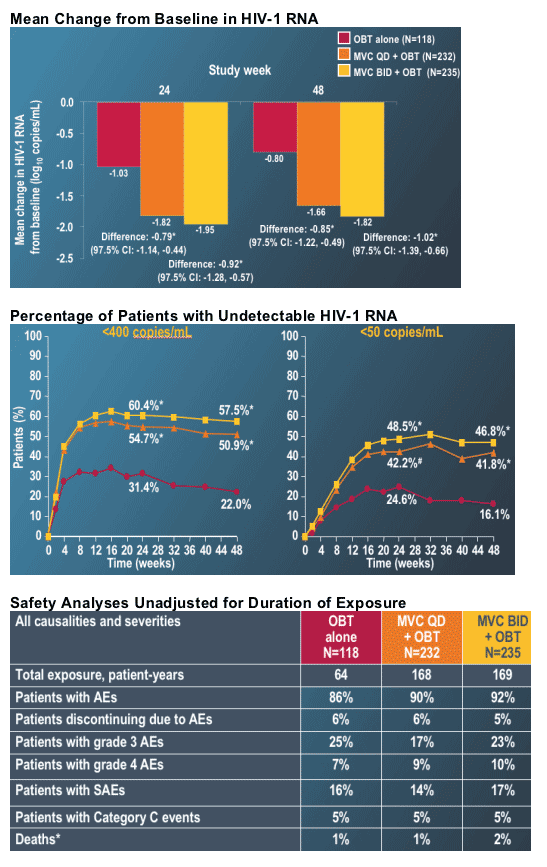
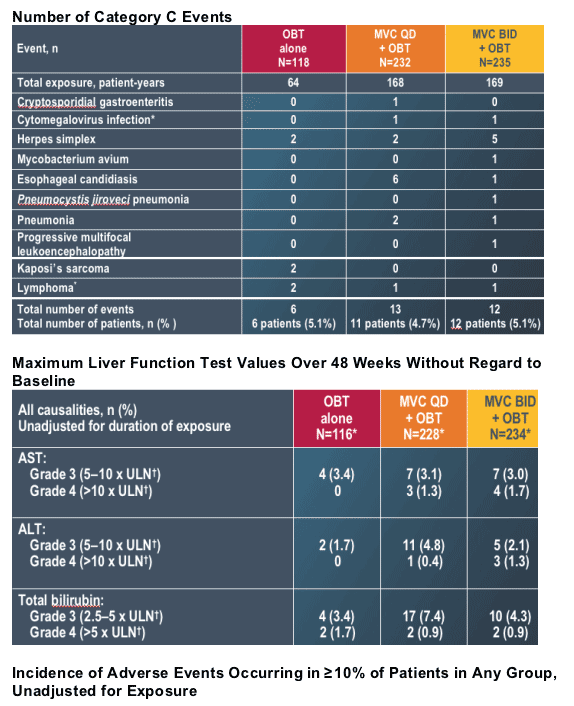
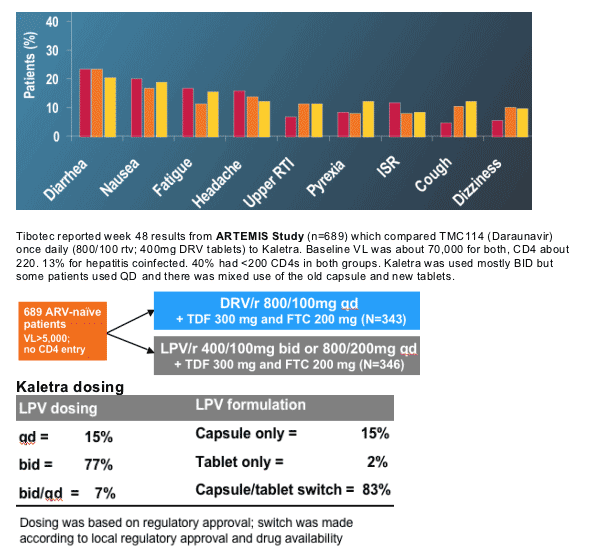
Discontinuation rate was 12% with DRV and 16% with LPV/r. Discontinuation due to AE was 3% for DRV and 7% for Kaletra. TDF/FTC was also used. Viral failure was <1% (2) in DRV and 2% (6) in Kaletra. VL <50 c/ml at week 48 was 84% for DRV QD and 78% for Kaletra. DRV was non-inferior (p< 0.001). But not superior (p=0.062). For patients with <50 CD4 at baseline 77% achieved <50 c/ml taking DRV and 67% taking Kaletra, for patients with CD4 50-200 80% for DRV and 71% for Kaletra for patients with >200 CD4 87% for DRV and 84% for Kaletra, and for patients with >100,000 VL 79% for DRV and 67% for Kaletra. 81% taking Kaletra BID & 71% taking Kaletra QD vs 84% for DRV had <50 c/ml. There were 34 viral failures (10%) (>50 c/ml) in DRV group and 49 (14%) in the Kaletra group; using >400 c/ml as VF 11 (3%) in DRV group and 18 (5%) in Kaletra group. For resistance evaluation they had 10 in DRV & 18 in Kaletra groups with paired baseline & VF genotype available. There were no PI mutations found in the DRV & Kaletra viral failures except for 1 patient on Kaletra (A71T, V77I); NRTI mutations reported: there were 3 people who developed M184V (1 DRV, 2 LPV arm) (the table below is wrong regarding NRTI mutations). Diarrhea: 10% of patients on Kaletra, 4% on DRV; rash: 3% in DRV, 1% on Kaletra. Grade 2-4 lab abnormalities: total cholesterol (fasting lipids)- 13% DRV, 23% Kaletra; low-density lipoprotein 13% DRV, 11% Kaletra, triglycerides 3% DRV, 11% Kaletra. Mean TG was about 200 on Kaletra, 140 on DRV; total cholesterol/HDL ration was similar for both drugs at week 48, about 4.3. PK analysis showed DRV 800/100 QD well above, several fold above levels needed for suppression of wild-type HIV.
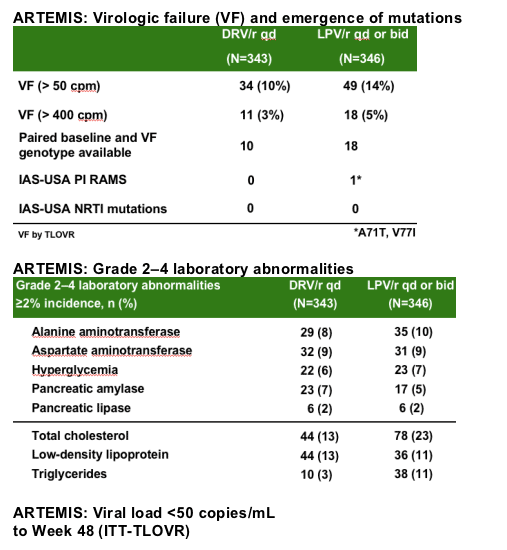
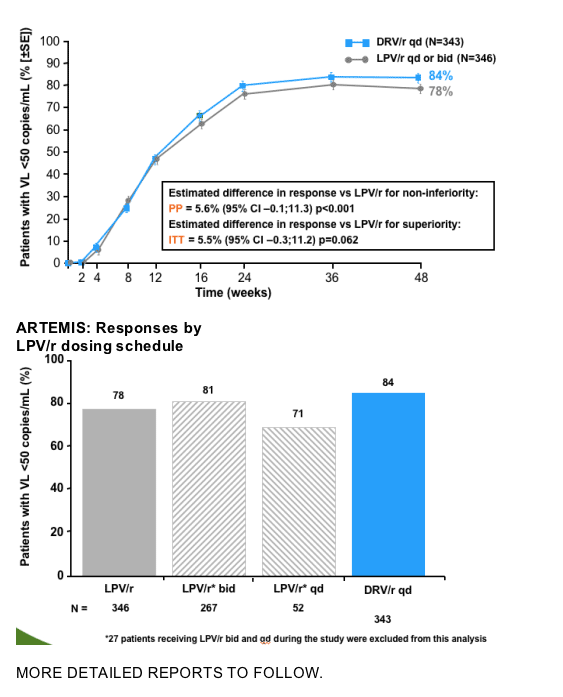
|
| |
|
 |
 |
|
|